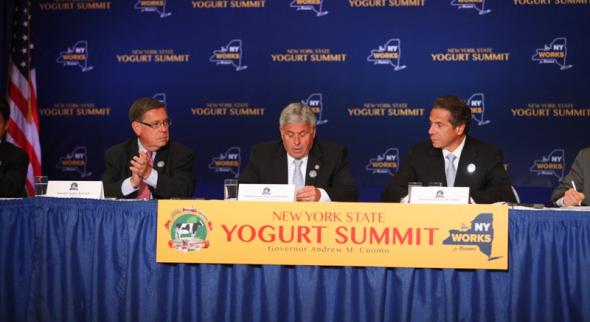New York dairymen are hoping to turn the Empire State into the land of yogurt and honey.
Well, yogurt anyway.
And it’s not just a passing consumer fancy: Gov. Andrew M. Cuomo hosted the first New York Yogurt Summit in August, and Cornell University held a forum, “The Yogurt Revolution,” Nov. 8.
Since 2000, there has been a boom in yogurt production in New York, with the number of yogurt processing plants more than doubling from 14 to 29. PepsiCo and the Theo Muller Group of Germany unveiled plans in August to site a Muller Quaker Dairy yogurt plant in Batavia, in western New York, and in mid-November Byrne Dairy announced plans to build yet another plant near the Finger Lakes town of Cortland in 2013.
One of the newer plants is Chobani, headquartered in Norwich, N.Y., which started in 2005 and now does $1 billion in sales. Billion.
At a time (2005-11) when the state’s manufacturing jobs dropped 9 percent, the state’s dairy manufacturing job base increased by 3 percent. (If you’ve read my sermons about agriculture being a great economic development driver, this shouldn’t surprise you.)
Most of the yogurt is the newer Greek style yogurt, which is thicker and takes three times more milk than traditional yogurt to produce.
All this has been good news for milk producers. The amount of milk used to make yogurt in New York increased from 158 million pounds to about 1.2 billion pounds. Again, billion.
This growth doesn’t just happen. Well, maybe it begins in a random fashion, but to continue sustained business growth takes both private and public buy-in.
Cuomo showed the government’s good faith at his summit in August by announcing changes to the state’s Concentrated Animal Feeding Operation (CAFO) regulations that would exempt non-discharging, medium-sized farms (between 200-299 mature dairy cows) from existing CAFO State Pollutant Discharge Elimination System (SPDES) permitting requirements, and other regulations regarding land application, manure storage or composting.
A report released in June by Farm Credit East and Cornell Pro-Dairy found the N.Y. CAFO regs that kick in at 200 cows add $142,000 in capital costs, $15,000 for an initial Comprehensive Nutrient Management Plan, and $5,000 each year for annual updates (if you were expanding from 190 cows to 290 cows).
New York currently required CAFO permit coverage at 200 mature dairy cows and the proposed change would increase that to 300 cows.
The state and local counties are also serving up a chunk (millions) in tax breaks to those building the manufacturing plants (companies that include PepsiCo). The state is also incentivizing the construction and use of anaerobic digesters that can turn the food or farm waste into energy.
And Cornell will open the doors to a $105 million food science/processing building renovation next spring that will feature a 12,000-square-foot dairy processing plant where both students and industry representatives can be trained, as well as a food processing lab that industry can use to develop new products.
Some are touting New York’s yogurt empire as the equivalent to California’s Silicon Valley. Let’s hope it keeps growing, one spoonful at a time.
By Susan Crowell













